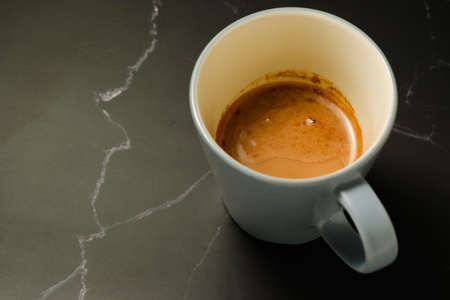Understanding the Flat White: A British Perspective
The flat white has secured its own devoted following in the UK, standing apart from the more traditional lattes and cappuccinos found on British high streets. At its core, a flat white is an espresso-based coffee drink that strikes a delicate balance between strong, robust coffee flavour and silky, microfoam milk. Unlike a latte, which typically comes in a larger cup with more steamed milk, or a cappuccino, known for its thick layer of frothy foam and dusting of chocolate, the British flat white offers something distinctly different—a smaller volume, typically served in a 6oz to 8oz cup, with a fine, velvety milk texture that integrates seamlessly with the espresso.
In the UK, coffee culture has evolved rapidly over the past decade, embracing influences from Australia and New Zealand—countries often credited with inventing the flat white. Yet, British coffee shops have made this drink their own. The hallmark of a British flat white is its harmonious proportion of espresso to milk: enough to showcase the nuanced notes of quality beans, but with just enough creamy microfoam to round off any bitter edges. For many Brits, ordering a flat white signals an appreciation for craft and subtlety rather than sheer size or sweetness.
Flat whites occupy a unique niche in British coffee culture. They are favoured by those who seek a stronger coffee hit without overwhelming milkiness or excessive foam. While some may debate the “authentic” recipe or ideal cup size, most UK baristas agree on two things: the importance of using well-textured microfoam and serving the drink at just the right temperature—not too hot—to preserve both flavour and mouthfeel. As speciality cafés continue to flourish across Britain’s cities and towns, the flat white has become not only a staple menu item but also a symbol of evolving tastes and growing expertise within the UK’s vibrant coffee scene.
2. A Brief History of the Flat White
The flat white, though now a staple in British coffee culture, boasts an intriguing journey from its origins in Australasia to widespread popularity across the UK. The debate over its birthplace is ongoing, with both Australia and New Zealand laying claim to its invention during the 1980s. Initially, the flat white was designed as an alternative to froth-heavy cappuccinos and milky lattes, offering a stronger coffee flavour paired with a smooth, velvety microfoam.
When the flat white made its way to Britain in the early 2000s, it quickly gained traction among coffee aficionados seeking something distinct from traditional British café offerings. Its rise coincided with the third wave coffee movement in the UK, which emphasised quality beans and skilled barista techniques. British cafés saw an opportunity to cater to evolving tastes and began to adapt the flat white to local preferences.
Adaptations in British Cafés
| Original Australasian Flat White | British Adaptation |
|---|---|
| Typically served in a 150–180ml ceramic cup | Often presented in slightly larger cups (180–220ml) |
| Double ristretto espresso base for intense flavour | Frequently uses double espresso shots or single origin beans for nuanced taste |
| Smooth microfoam with minimal froth, integrated milk texture | Emphasis on silky texture, but some cafés allow for slightly more foam by request |
| No added toppings or syrups | Syrups and non-dairy milks available upon request to suit British preferences |
The Flat White’s Place in British Coffee Culture
The adoption of the flat white reflects Britain’s growing appreciation for specialty coffee and artisan brewing methods. Today, it is a fixture on nearly every high street menu—from independent roasteries in Bristol and Edinburgh to chains like Pret A Manger and Costa. The drinks balance between strength and creaminess appeals to British palates, providing a reliable choice for those who want more than a standard latte but less foam than a cappuccino.

3. Essential Ingredients and Kit
To craft a truly authentic British flat white at home, you’ll need to pay careful attention to the core ingredients and equipment. Let’s break down what’s essential—and where to find the best of British-sourced products.
Coffee Beans: The Foundation
A proper flat white starts with freshly roasted, high-quality coffee beans. In the UK, speciality roasters such as Union Hand-Roasted, Caravan Coffee Roasters, or Origin Coffee are excellent options readily available online or in independent shops across cities like London, Manchester, and Edinburgh. Aim for a medium roast with sweet, nutty notes—these pair beautifully with milk and bring out the nuanced flavours that set a flat white apart from other espresso drinks.
Recommended British Roasters:
- Union Hand-Roasted Coffee (found in Waitrose and Sainsbury’s)
- Caravan Coffee Roasters (available direct or via specialty cafés)
- Grind (with locations across London and online shop)
Milk: Texture and Taste Matter
The hallmark of a great flat white is its microfoam—a creamy, velvety milk texture that blends seamlessly with espresso. For this, opt for fresh whole milk from local dairies; brands such as Yeo Valley or Duchy Organic offer excellent quality and are widely stocked in British supermarkets. If you’re plant-based, try Oatly Barista Edition, known for its steaming properties and smooth finish, available in Tesco and Sainsbury’s.
Top Milk Picks:
- Yeo Valley Whole Milk
- Duchy Organic Whole Milk
- Oatly Barista Edition (for dairy-free alternative)
The Essential Kit: What You Need
You don’t need a café-sized setup, but investing in the right tools makes all the difference. A reliable espresso machine is key—entry-level favourites like the Sage Bambino Plus or De’Longhi Dedica are popular on the high street and deliver consistent results. Pair your machine with a good burr grinder; Wilfa Svart Aroma or Sage Smart Grinder Pro are both readily available in John Lewis or Lakeland.
Your Home Brewing Checklist:
- An espresso machine with steam wand (Sage, De’Longhi, Gaggia Classic)
- Burr grinder for fresh beans (Wilfa Svart Aroma, Sage Smart Grinder Pro)
- Stainless steel milk jug (available from IKEA or Lakeland)
- A thermometer for accurate milk steaming (optional but handy)
A Note on Accessibility:
If you’re just starting out or working with a modest budget, consider stovetop espresso makers (like Bialetti) paired with electric milk frothers—both can be found easily at Argos or Robert Dyas. While not quite café-standard, they’re more than capable of delivering a satisfying flat white experience at home.
4. Perfecting the Technique
Mastering the art of the flat white at home is both a rewarding and highly achievable goal. The British take on this antipodean classic emphasises not only the robust flavour of espresso but also the seamless integration of microfoam, resulting in a drink that is velvety yet strong. Below, you’ll find a step-by-step breakdown for brewing an authentic British flat white, along with practical tips to ensure your cup rivals any high street café.
Step-by-Step Method for Crafting a Flat White
| Step | Description |
|---|---|
| 1. Prepare Your Espresso | Start by grinding fresh coffee beans to a fine consistency – slightly finer than table salt. For best results, use around 18g of coffee for a double shot. Use a quality espresso machine (or stovetop Moka pot as an alternative) to extract a rich, balanced shot; aim for 25-30 seconds extraction time. |
| 2. Texture the Milk | Use cold, whole milk for authentic creaminess. Steam the milk to around 60–65°C (avoid overheating to prevent scalding). Position the steam wand just below the surface to introduce air, creating microfoam—tiny, glossy bubbles that give the milk its silky texture. Swirl the jug afterwards to incorporate any larger bubbles. |
| 3. Pour with Precision | Hold your cup at an angle and pour the espresso first. Gently pour your microfoamed milk over the espresso, allowing it to mix naturally and create a signature ‘white dot’ or simple latte art on top. |
Essential Tips for British Perfection
- Espresso Matters: Opt for blends favoured in British cafés—nutty or chocolatey notes work brilliantly.
- The Right Ratio: Traditional British flat whites use a smaller cup (5–6oz), keeping the balance of coffee and milk spot-on.
- Cup Warmth: Pre-warm your cup to maintain temperature and mouthfeel.
Troubleshooting Common Issues
| Problem | Solution |
|---|---|
| Flat or bubbly milk | Purge steam wand before and after steaming; focus on introducing minimal air at the start only. |
| Bitter espresso | Check grind size and extraction time; under-extracted shots taste sour, over-extracted are bitter. |
Nailing these techniques will elevate your home brewing game, ensuring each flat white is as smooth and satisfying as anything found in Britain’s finest independent coffee shops.
5. Troubleshooting and Barista Tips
Common Flat White Challenges in the British Home
Brewing a spot-on flat white at home isn’t always straightforward, even for seasoned enthusiasts. The British penchant for a perfectly balanced cup means any misstep can stand out. Here are some classic flat white issues you might encounter:
- Milk That’s Too Frothy or Too Thin: Flat whites demand microfoam – smooth, velvety, and not overly airy. If your milk resembles the froth of a cappuccino, you’ve likely introduced too much air. Conversely, if it’s flat and lifeless, you may need to improve your steaming technique.
- Bitter or Overpowering Espresso: A flat white should showcase espresso without letting bitterness dominate. This often results from over-extraction or using beans that are too darkly roasted.
- Poor Milk-Espresso Integration: Sometimes the milk sits on top rather than merging seamlessly with the coffee beneath. This impacts both texture and taste.
Pro Solutions from British Baristas
Perfecting Milk Texturing
According to London-based baristas, achieving “proper microfoam” is all about listening and watching. Use cold, fresh whole milk for the best results. Start by submerging the steam wand just below the surface and listen for a gentle hissing sound—avoid aggressive bubbling. Once the jug feels warm (not hot), angle it slightly and keep spinning the milk until it has a glossy, paint-like consistency.
Balancing Flavours Like a Pro
British specialty cafés often use single-origin beans for their nuanced profiles but recommend blends for home brewers seeking consistency. To avoid bitterness, aim for an espresso extraction time of 25–30 seconds and adjust grind size as needed. Taste as you go: if your flat white is too sharp, try a lighter roast; if it’s too milky, reduce your milk volume slightly or use a double shot of espresso.
The Pour: Bringing It All Together
When pouring, swirl your milk jug before you start to integrate foam and liquid. Pour steadily into the centre of your espresso, then move closer to the cup’s surface as you finish to create that signature flat white dot or heart—no need to get fancy unless you’re feeling artistic.
Final Word from the British Coffee Scene
The secret to mastering the British flat white lies in patience, practice, and attention to detail. Don’t be discouraged by early mishaps—every barista has spilt more than one jug of milk learning their craft! With these troubleshooting steps and tips straight from UK coffee pros, your next homemade flat white will be worthy of any high street café.
6. Enjoying Your Flat White: British Style
Savouring a flat white at home is more than just sipping a well-made coffee; its about embracing the ritual and infusing it with local character. Here’s how to elevate your experience and give it a distinctly British twist.
Perfect Pairings: British Pastries and Bakes
A flat white’s velvety texture and balanced strength pair brilliantly with classic British pastries. Consider serving your coffee alongside a warm slice of buttery Victoria sponge, or perhaps a crumbly scone topped with clotted cream and jam. For those who prefer something less sweet, try oat biscuits or a traditional Bakewell tart. These treats not only complement the flavours of the espresso and milk but also add a comforting sense of occasion to your coffee break.
Setting the Scene: Creating a Cosy Coffee Ritual
British culture values comfort and cosiness—think ‘hygge’ with an English accent. Settle in by your favourite window seat or wrap yourself in a soft jumper. Use your best mug, perhaps one adorned with cheeky British sayings or heritage patterns, to make the moment feel special. Take time to savour each sip and bite, letting the mellow bitterness of the coffee mingle with the sweetness of your chosen bake.
Local Twists: Personalising Your Flat White
To put your own spin on the flat white, consider using locally roasted beans from one of Britain’s many independent coffee roasters. Add a dash of oat or dairy milk from regional producers for an authentically local taste. Some enjoy sprinkling a pinch of nutmeg or cinnamon on top—a subtle nod to traditional British baking spices.
Slow Down and Savour
Above all, enjoying your flat white at home should be unrushed. Whether you’re catching up on the morning news, diving into a good book, or simply watching the rain outside, allow yourself to linger. The true British approach is about making time for small pleasures—and with the right brew, every cup can become its own comforting ritual.


